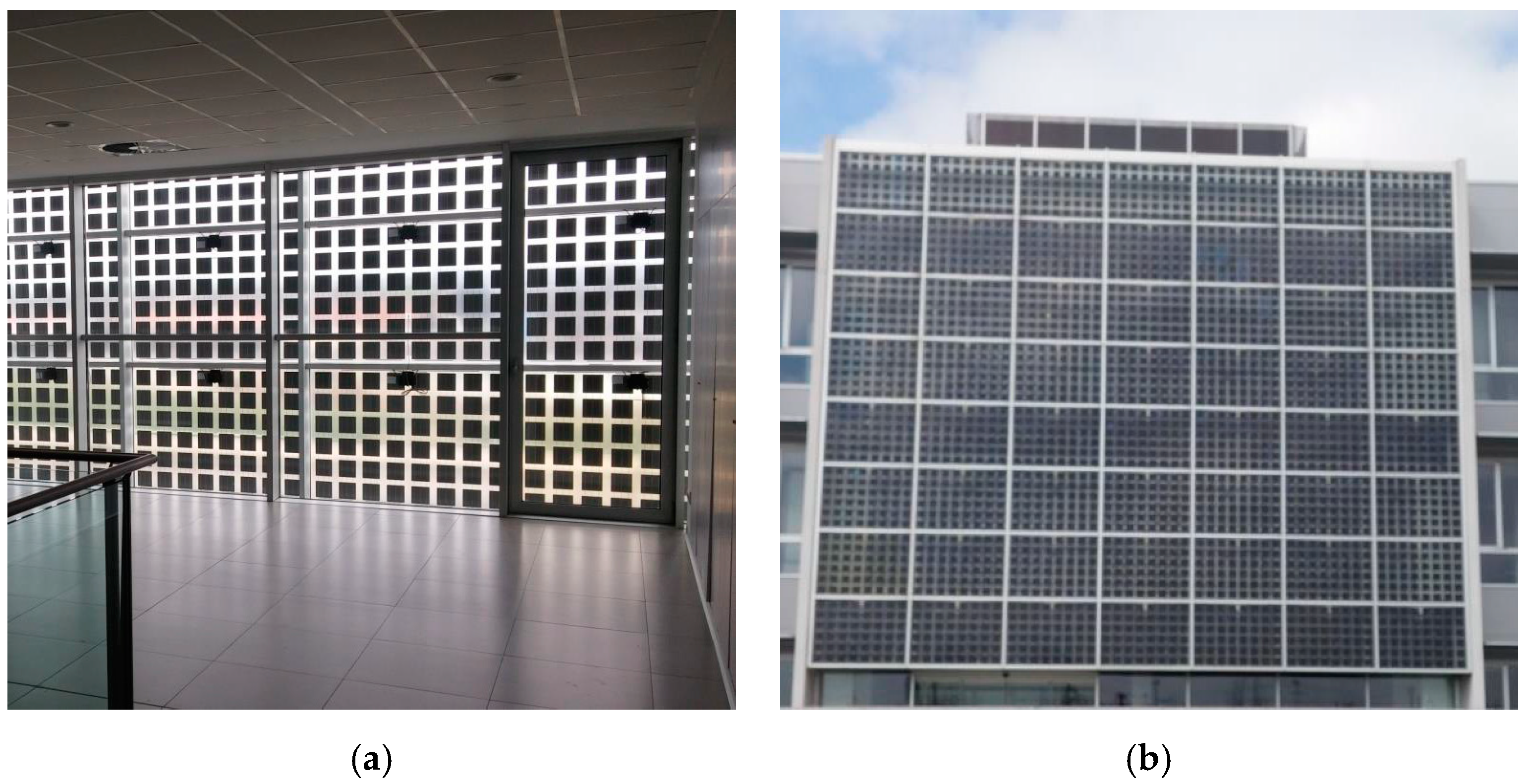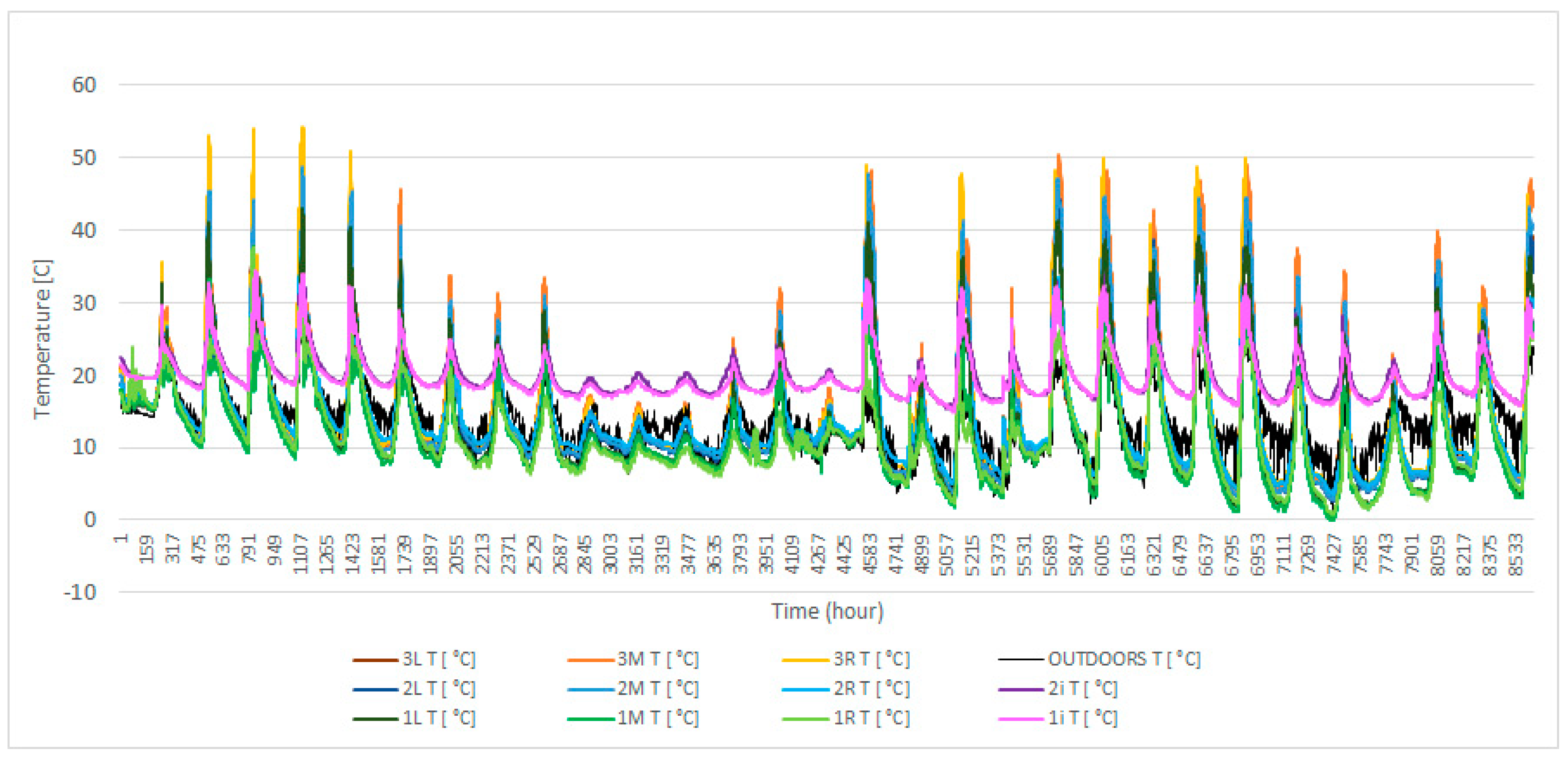Improved Performance of a PV Integrated Ventilated Façade at an Existing nZEB †
Abstract
:1. Introduction
2. Materials and Methods
3. Results
3.1. Radiative Properties of the Façade
3.2. Operating Behavior of the Façade
4. Discussion
5. Conclusions
Author Contributions
Acknowledgments
Conflicts of Interest
References
- Benemann, J.; Chehab, O.; Schaar-Gabriel, E. Building-integrated PV modules. Sol. Energy Mater. Sol. Cells 2001, 67, 345–354. Available online: https://doi.org/10.1016/S0927-0248(00)00302-0 (accessed on 3 February 2019).
- Shahrestani, M.; Yao, R.; Essah, E.; Shao, L.; Oliveira, A.C.; Hepbasli, A.; Biyik, E.; Cano, T.; Rico, E.; Lechón, J.L. Experimental and numerical studies to assess the energy performance of naturally ventilated PV façade systems. Sol. Energy 2017, 147, 37–51. Available online: https://doi.org/10.1016/j.solener.2017.02.034 (accessed on 3 February 2019).
- Gaillard, L.; Giroux-Julien, L.; Ménézo, C.; Pabiou, H. Experimental evaluation of a naturally ventilated PV double-skin building envelope in real operating conditions. Sol. Energy 2014, 103, 223–241. [Google Scholar] [CrossRef]
- Lau, S.K.; Zhao, Y.; Shabunko, V.; Chao, Y.; Lau, S.S.Y.; Tablada, A.; Reindi, T. Optimization and Evaluation of Naturally Ventilated BIPV Façade Design. Energy Procedia 2018, 150, 87–93. Available online: https://doi.org/10.1016/j.egypro.2018.09.003 (accessed on 3 February 2019).
- Li, Y.; Zhuang, Z.; Tan, H.; Su, W. Simulation Study of a Naturally-ventilated Photovoltaic (PV) Façade for High-rise Buildings. Procedia Eng. 2017, 205, 1381–1388. Available online: https://doi.org/10.1016/j.proeng.2017.10.291 (accessed on 3 February 2019). [CrossRef]
- Spanish Building Standard (CTE). 2006. Available online: https://www.codigotecnico.org/ (accessed on 4 February 2019).



| Parameter | No. (Position) | Sensor | Range | Accuracy |
|---|---|---|---|---|
| DBT/RH | 9 (inside façade) 2 (indoor air) | Testo datalogger 175 H1 | −20 °C to +55 °C 0 to 100% | ±0.4 °C ±2 %RH |
| DBT/RH | 1 (outdoor air) | Geonica STH-S331 1 | −40 °C to +60 °C | ±0.1 °C |
| Surface temp. | (Various positions) | Testo Thermocouple K 0602 0393 | −60 °C to +300 °C | ±2.5 °C |
| Surface temp. | (Various positions) | FLIR InfraCAM | −10 °C to +350 °C | <0.1 °C |
| Solar radiation | (Various positions) | Ahlborn ALMEMO FLA628 S Piranometer | 0 to 1500 W/m2 | ±7% |
| Solar radiation | 1 (roof) | HUKSEFLUX SR20-T2-10 Piranometer 1 | 0 to 4000 W/m2 | ±3% |
| Surface | Transmissivity | Absorptivity |
|---|---|---|
| PV cells | 0.094 | 0.91 |
| Outdoor glass | 0.42 | 0 |
| Outdoor glass with PV cells | 0.37 | - |
| Indoor glass | 0.25 | - |
Disclaimer/Publisher’s Note: The statements, opinions and data contained in all publications are solely those of the individual author(s) and contributor(s) and not of MDPI and/or the editor(s). MDPI and/or the editor(s) disclaim responsibility for any injury to people or property resulting from any ideas, methods, instructions or products referred to in the content. |
© 2019 by the authors. Licensee MDPI, Basel, Switzerland. This article is an open access article distributed under the terms and conditions of the Creative Commons Attribution (CC BY) license (https://creativecommons.org/licenses/by/4.0/).
Share and Cite
Tejero-González, A.; Krawczyk, D.A.; Rey-Martínez, F.J.; Velasco-Gómez, E. Improved Performance of a PV Integrated Ventilated Façade at an Existing nZEB. Proceedings 2019, 16, 22. https://doi.org/10.3390/proceedings2019016022
Tejero-González A, Krawczyk DA, Rey-Martínez FJ, Velasco-Gómez E. Improved Performance of a PV Integrated Ventilated Façade at an Existing nZEB. Proceedings. 2019; 16(1):22. https://doi.org/10.3390/proceedings2019016022
Chicago/Turabian StyleTejero-González, Ana, Dorota Anna Krawczyk, F. Javier Rey-Martínez, and Eloy Velasco-Gómez. 2019. "Improved Performance of a PV Integrated Ventilated Façade at an Existing nZEB" Proceedings 16, no. 1: 22. https://doi.org/10.3390/proceedings2019016022
APA StyleTejero-González, A., Krawczyk, D. A., Rey-Martínez, F. J., & Velasco-Gómez, E. (2019). Improved Performance of a PV Integrated Ventilated Façade at an Existing nZEB. Proceedings, 16(1), 22. https://doi.org/10.3390/proceedings2019016022






